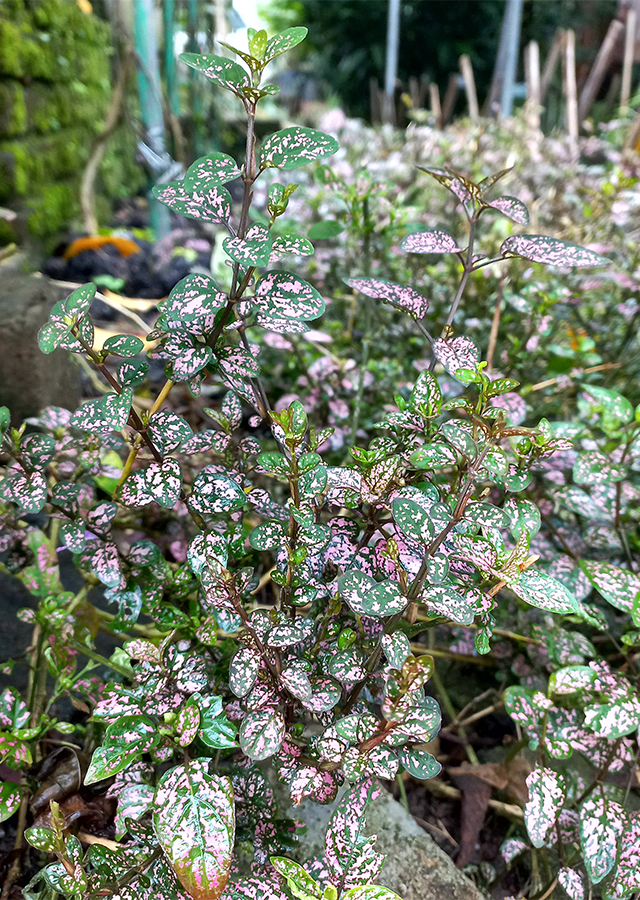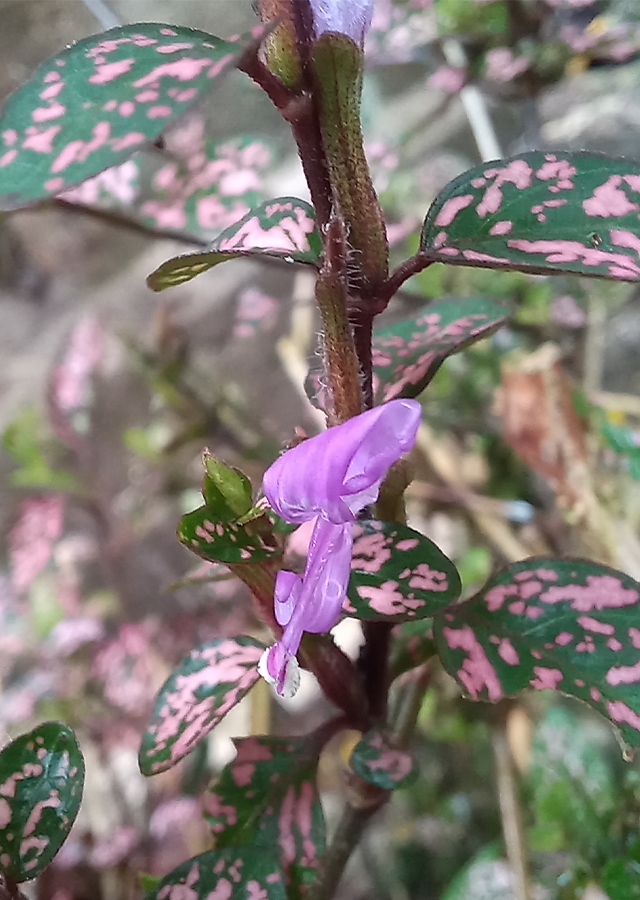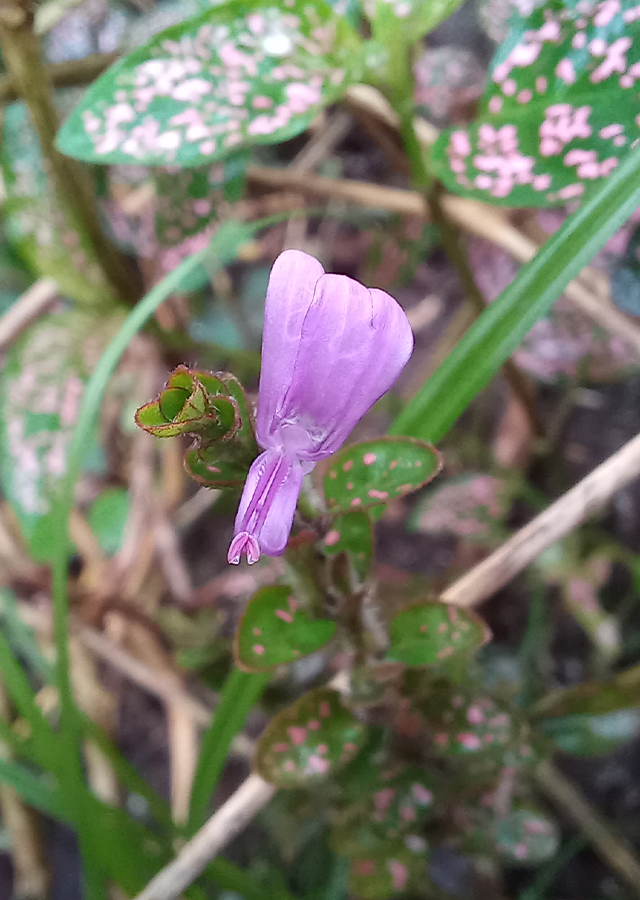Polka Dot Plant
Hypoestes phyllostachya Baker
Acanthaceae
Location in our garden
Shading Area



Synonym
Eranthemum sanguinolentum Veitch ex Van Houtte
Hypoestes sanguinolenta (Veitch ex Van Houtte) Hook.
Habitus
Herbaceous. Herbaceous perennial plant, growing to 60 cm tall
Part Used
Leaves
Growing Requirements
Need Shade
Habitat
Terrestrial
Overview
Hypoestes phyllostachya is native to Madagascar, and introduced to Assam, Colombia, Costa Rica, East Himalaya, El Salvador, Guatemala, Honduras, India, Mexico, Norfolk Island, Panamá, and Paraguay. It is cultivated as ornamental plant and is also used for traditional medicines. Suitable for use as an annual bedding plant, in containers, terrariums, and as a houseplant.
Vernacular Names
No found data on this. Need further research.
Agroecology
Summer temperatures of around 21 °C are ideal for polka dot plants. The location should be very bright but not be subject to direct sunlight. These delicate plants do not enjoy the cold at all. If the temperature falls below 15 °C, it will begin to suffer. These plants are also sensitive to cold droughts. The polka dot plant thrives in an environment where the humidity is roughly 50%. Bedding plants are best grown in organically rich, medium moisture, well-drained soils in part shade.
Morphology
- Stem - branched, cylindrical, jointed.
- Leaves - opposite, 2- 4.5 x 1-2.5 cm, lanceolate, elliptic ovate, acute, entire, variegated; petiole 1-2.2 cm long, glabrous.
- Flowers - axillary, bracts 4, jointed about the terminal end, lobed spathe like, unequal in size, 2 are pointed, other two are obovate, 1-1.5 x 0.1-0.2 cm, hirsute, dark green. Flowers 1 or 2 within the bract. Sepals 5, pale white, hirsute at the tip, lanceolate. Corolla white, tube narrow at the base, ca. 0.7 x 0.1 cm, then dilated and curved, bilipped, lower 3 lobed, lobes ca 0.9 x 0.5 cm, upper 2 lobed, lobes narrow, 1-1.2 x 0.1 cm, pubescent on the dilated and lower part of the lobes. Stamens 2, filaments 0.7-0.9 cm, hairs downwardly pointed sparse, anthers lobe yellow. Ovary 0.2 x 0.1 cm, oblong, tip pointed, glabrous; ovules 4; style 1.7- 1.9 cm, stigma slightly bifid; disc membranous, 4-5 lobed.
- Fruit - a capsule, elongated, 0.3-0.4 x 0.1 cm, puberulous.
- Seeds - 4, glabrous.
Cultivation
- Generative propagation is by seed. Seeds should be placed on top of the soil and then watered. Soil will suffocate them.
- Vegetative propagation is by stem cutting. We need to harvest cuttings in the beginning of spring. These cuttings are gathered around the base of the plant. Then dip those cuttings in root hormone and plant them in fresh, moist soil.
- The plant requires feeding but only once the roots have developed to a specific point. If the plant is young, then don’t fertilize it right away. Give it time to adapt after transplanting so that its roots have time to spread and make their home in the new soil. Start feeding the plant at the beginning of spring and then set up a regular schedule. Fertilizing the Hypoestes Phyllostachya will enhance its color and creates a more vibrant look.
Chemical Constituents
Diterpenoid furanolabdane, (3R,6R,7E)-3-hydroxy-megastigma-4,7-dien-9-one, (3S)-3-hydroxy-β-ionone, (3S,5R,6S,7E)-5,6-epoxy-3- hydroxy-megastigma-7-en-9-one, grasshopper ketone, vomifoliol, (+)-dehydrovomifoliol, loliolide, 2,6-dimethyl- 2E,7-octadien-1,6-diol, bifurcanol, (12S)-hydroxygeranylgeraniol, nectandrin B, N-trans-feruloyltyramine, syringylethanone, paeonol, vanillin, dehydrozingerone, 2-hydroxybenzyl alcohol, (2E)-4-hydroxy-2- hexenoic acid.
Traditional Medicinal Uses
It has potency in the treatment of hypertension, heart disease and stroke, hematoma, to relieve pain and inflammation.
Part Used
Reference Sources
- Anna In the House. (2021). House Plants: Polka Dot Plant Care Guide. https://annainthehouse.com/polka-dot-plant-care-guide/. 16-12-2021.
- EFlora of India. (2007). Database of Plants of Indian Subcontinent: Hypoestes phyllostachya. https://sites.google.com/site/efloraofindia/species/a---l/a/acanthaceae/hypoestes/hypoestes-phyllostachya. 16-12-2021.
- Kew Royal Botanic Gardens. (2017). Plants of the World Online: Hypoestes phyllostachya Baker https://powo.science.kew.org/taxon/urn:lsid:ipni.org:names:49962-1. 16-12-2021.
- Missouri Botanical Gardens. (No date). Hypoestes phyllostachya. https://www.missouribotanicalgarden.org/PlantFinder/PlantFinderDetails.aspx?kempercode=a515. 16-12-2021.
- My Garden. (2021). Polka Dot Plant. https://amp.mygarden.com/plants/polka-dot-plant. 16-12-2021.
- National Park of Singapore. (2021). Flora & Fauna Web: Hypoestes phyllostachya. https://www.nparks.gov.sg/florafaunaweb/flora/8/1/8117. 16-12-2021.
- Yan, T., et al. (2018). Chemical constituents from aerial parts of Hypoestes phyllostachya. Chinese Traditional and Herbal Drugs 49(8):1767-1772. DOI:10.7501/j.issn.0253-2670.2018.0.

